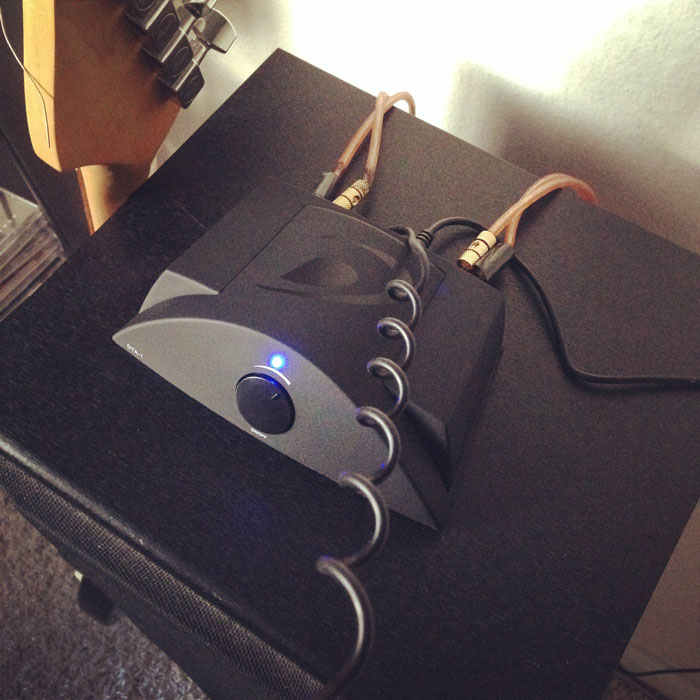Review: Dayton Class T Amplifier DTA-1
I couldn’t bear to part with my favorite analog speakers. They turned twenty five years old this year. My EPI speakers were a big part of my life growing up. In fact, they were part of my very first component stereo purchase back in the summer of 1989. These analog speakers held a lot of fond memories for me over the years and – now – are all that is left of my late, lamented component stereo system.
As far as I knew, these speakers still worked. But there they were, gathering dust and sitting forlorn in a closet, ready to make their inevitable way to the donate pile. That is, until my happenstance encounter with an article on Class T amplifiers…
Wikipedia defines a Class T amplifier as “a switching (Class D) audio amplifier switched at very high (50MHz) frequency.” Which is all fine and dandy, but those words had no meaning for me. All I wanted was an inexpensive method of connecting my old analog speakers to my digital gadgets and the Class T amp was the ticket.
So I did my research…
A few weeks later, I found myself as the proud owner of the Dayton Audio Class T Digital Audio Amplifier model DTA-1. The Dayton DTA-1 retails for $60, but can be found online for under $39. This is the box the unit ships in.
Inside the Box
Inside the box you’ll find a quick start user manual, a small 3.5mm male to male cable, a power supply brick, a European power converter and the amplifier itself. Everything comes securely packed.
The DTA-1 is made out of a sturdy, matte plastic. It has some heft to it, enough to where it won’t slide around when wires are connected to it. On the front of the unit is a power / volume knob.
On the back of the unit, you’ll find analog speaker wire inputs, a port for connecting AC power, and a 3.5mm audio input jack. Specification wise, the DTA-1 is rated at 30 watts, with less than 0.04% total harmonic distortion (THD) at 9 watts. It also connects to any 4 ohm / 8 ohm speakers. The DTA-1 can also accommodate up to 8 AA batteries for portable use, but I did not test this facet of the product as I’ll be using it in a fixed location.
Connecting it up was straight forward with two caveats.
The first caveat is that you’ll want to use a proper connector affixed to your speaker wire. Threading in speaker wire without a connector is nearly impossible, given the small sockets on the DTA-1.(If you’re going to use connectors, you’ll want to shield them so that they don’t accidentally short. I used some duct tape for the positive terminals to prevent that from happening.)
The second caveat is that the springs on the analog speaker wire input spring mechanisms require a delicate touch. If you pull the mechanisms too far, you’ll easily pop one of the springs out. This, in fact, happened to me. The clasp of the speaker wire input mechanism was a tad loose for my taste, but the springs can easily be put back in, as long as you don’t lose them.
Once you have the speakers plugged in, connect the DTA-1 to your favorite input device and turn the volume / power knob clockwise. When powering up the DTA-1, you won’t hear the annoying “pop” thanks to its suppression.
The DTA-1 will accept any 3.5mm input, so any gadget or computer that has the equivalent should work with it.
How does it Sound?
Disclaimer: I am not an audiophile. Nor do I pretend to be one.
To my ears, which have experienced a wide variety of audio input stimuli, the DTA-1 coupled with my EPI speakers sound great. The DTA-1’s drive my speakers without any distortion whatsoever, and (to my ears) the audio sounds clear, full, and warm – across the range of high and low frequencies. Bass notes don’t distort or fuzz out. It’s a really nice sounding piece of kit. For testing purposes, I played the soundtrack to the movie “Inception” as well as a few vocal based tracks from Wayne Newton, Cheap Trick and Johnny Cash.
While planning this review, I wanted to have a video component so you could actually hear the sound that comes out. Alas, codec issues and the lack of a decent consumer level video editing tool on the Mac sidelined my plans. (Side note: iMovie is completely unusable for me.) You’ll just have to trust me when I say that this little amp sounds terrific for the price. The DTA-1 is perfect for my small studio office, but I can imagine people using the DTA-1 for piping audio to their garage or patio.
Final Thoughts
Reviewing audio products is very difficult for me and (truthfully) somewhat subjective when it comes to evaluating the specifics as to what constitutes “good” sound. The pros of the unit (great, rich sound, affordable price) outweigh any negatives (wire clasps being somewhat flimsy). The DTA-1 is a solid purchase if you have a pair of old analog speakers you want to repurpose. My EPI speakers are happy to be recommissioned, and I’m happy that the solution didn’t break the bank.
The DTA-1 earns 4 out of 5 Bob Weiners.











James W
November 21, 2016 at 8:43 amParts Express was having a sale. This amplifier and a matching pair of 2 way speakers, For 70 bucks with the shipping.
And it sounds good. I patched my internet radio and an old Rotel CD player through it and the sound is great. To my ears.